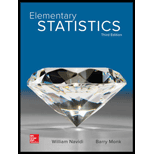
Elementary Statistics ( 3rd International Edition ) Isbn:9781260092561
3rd Edition
ISBN: 9781259969454
Author: William Navidi Prof.; Barry Monk Professor
Publisher: McGraw-Hill Education
expand_more
expand_more
format_list_bulleted
Concept explainers
Question
Chapter 15.2, Problem 16E
To determine
To find:Whether the median cost per load for high efficiency detergents differs from the median cost per load for standard detergent.
Expert Solution & Answer
Want to see the full answer?
Check out a sample textbook solution
Students have asked these similar questions
an attempt to develop a model of wine quality as judged by wine experts, data on alcohol content and wine quality was collected from variants of a particular wine. From a sample of 12wines, a model was created using the percentages of alcohol to predict wine quality. For those data, SR=18,671 and SST=27,382.Use this information to complete parts (a) through (c) below. Please complete part 3(B) ONLY.
Question content area bottom
Part 1
a. Determine the coefficient of determination,
r2,
and interpret its meaning.
r2=0.682
(Round to three decimal places as needed.)
Part 2
Interpret the meaning of r2.
It means that
68.2
of the variation in
wine quality
can be explained by the variation in
alcohol content.
(Round to one decimal place as needed.)
Part 3
b. Determine the standard error of the estimate.
SYX=
(Round to four decimal places as needed.)
The following data are from an experiment on carnations. The explanatory variable is the amount of inorganic bromine (micrograms per milliliter) in a plot of standard size. The
response variable is the average number of flowers per carnation plant for the 30 plants grown in the plot. Find the change in number of flowers per plant given an increase in 1 µg per
mL of inorganic bromine.
Amount of
bromine
Average no. of
flowers
Select one:
O a. -0.216
O b. 0.216
O c.
O d. -3.81
4.04
3
3.2
4
2.9
6
3.7
7
2.2
8
1.8
10
2.3
12
1.7
15
16
0.8 0.3
The data used is from college campuses. The variables used in the analysis below include: crime, total campus crime; enroll, total
enrollment; police, employed officers. Use the estimated OLS models to answer the questions below:
Model A:
In(crime) = -6.631 + 1.270ln(enroll),
(1.034) (.110)
n = 97; R² = .5804
Model B:
In(crime) = -4.794 + .923ln(enroll)
(.144)
(1.112)
n = 97; R² = .632
+.516ln(police),
(.149)
Using Model A, test the null hypothesis that elasticity of crime with respect to enrollment is unit elastic, i.e. equal to one (against a
two-sided alternative). Calculate the t-statistic.
Chapter 15 Solutions
Elementary Statistics ( 3rd International Edition ) Isbn:9781260092561
Ch. 15.1 - In Exercises 3 and 4, fill in each blank with the...Ch. 15.1 - Prob. 4ECh. 15.1 - Prob. 5ECh. 15.1 - In Exercises 5 and 6, determine whether the...Ch. 15.1 - Prob. 7ECh. 15.1 - Prob. 8ECh. 15.1 - Prob. 9ECh. 15.1 - Prob. 10ECh. 15.1 - Weight loss: A weight loss company claims that the...Ch. 15.1 - At the movies: A sample of 12 movies released in a...
Ch. 15.1 - Prob. 13ECh. 15.1 - Prob. 14ECh. 15.1 - Prob. 15ECh. 15.1 - Prob. 16ECh. 15.1 - Scam alert: The rates of fraud complaints (per...Ch. 15.1 - Prob. 18ECh. 15.1 - Prob. 19ECh. 15.2 - Prob. 3ECh. 15.2 - Prob. 4ECh. 15.2 - Prob. 5ECh. 15.2 - Prob. 6ECh. 15.2 - Prob. 7ECh. 15.2 - Prob. 8ECh. 15.2 - Prob. 9ECh. 15.2 - In Exercises 7-10, compute s,s, and the value of...Ch. 15.2 - Prob. 11ECh. 15.2 - Prob. 12ECh. 15.2 - Prob. 13ECh. 15.2 - Recovery times: A new postsurgical treatment was...Ch. 15.2 - Prob. 15ECh. 15.2 - Prob. 16ECh. 15.2 - Prob. 17ECh. 15.3 - Prob. 3ECh. 15.3 - Prob. 4ECh. 15.3 - Prob. 5ECh. 15.3 - Prob. 6ECh. 15.3 - Prob. 7ECh. 15.3 - Prob. 8ECh. 15.3 - Prob. 9ECh. 15.3 - Prob. 10ECh. 15.3 - Prob. 11ECh. 15.3 - Prob. 12ECh. 15.3 - Prob. 13ECh. 15.3 - Prob. 14ECh. 15.3 - Prob. 15ECh. 15.3 - Prob. 16ECh. 15.3 - Exercise 17 demonstrates that the results of the...Ch. 15 - Prob. 1CQCh. 15 - Prob. 2CQCh. 15 - Prob. 3CQCh. 15 - Prob. 4CQCh. 15 - Prob. 5CQCh. 15 - Prob. 6CQCh. 15 - Prob. 7CQCh. 15 - Prob. 8CQCh. 15 - In Exercises 8-10, use the signed-rank test to...Ch. 15 - Prob. 10CQCh. 15 - Prob. 1RECh. 15 - Prob. 2RECh. 15 - Prob. 3RECh. 15 - Prob. 4RECh. 15 - Prob. 5RECh. 15 - Prob. 6RECh. 15 - Prob. 7RECh. 15 - Prob. 8RECh. 15 - Prob. 9RECh. 15 - Prob. 10RECh. 15 - Prob. 1WAICh. 15 - Prob. 2WAICh. 15 - Prob. 3WAICh. 15 - Prob. 1CSCh. 15 - Prob. 2CSCh. 15 - Microorganisms play a crucial role in wastewater...Ch. 15 - Prob. 4CS
Knowledge Booster
Learn more about
Need a deep-dive on the concept behind this application? Look no further. Learn more about this topic, statistics and related others by exploring similar questions and additional content below.Recommended textbooks for you
 Calculus For The Life SciencesCalculusISBN:9780321964038Author:GREENWELL, Raymond N., RITCHEY, Nathan P., Lial, Margaret L.Publisher:Pearson Addison Wesley,
Calculus For The Life SciencesCalculusISBN:9780321964038Author:GREENWELL, Raymond N., RITCHEY, Nathan P., Lial, Margaret L.Publisher:Pearson Addison Wesley, Glencoe Algebra 1, Student Edition, 9780079039897...AlgebraISBN:9780079039897Author:CarterPublisher:McGraw Hill
Glencoe Algebra 1, Student Edition, 9780079039897...AlgebraISBN:9780079039897Author:CarterPublisher:McGraw Hill Big Ideas Math A Bridge To Success Algebra 1: Stu...AlgebraISBN:9781680331141Author:HOUGHTON MIFFLIN HARCOURTPublisher:Houghton Mifflin Harcourt
Big Ideas Math A Bridge To Success Algebra 1: Stu...AlgebraISBN:9781680331141Author:HOUGHTON MIFFLIN HARCOURTPublisher:Houghton Mifflin Harcourt

Calculus For The Life Sciences
Calculus
ISBN:9780321964038
Author:GREENWELL, Raymond N., RITCHEY, Nathan P., Lial, Margaret L.
Publisher:Pearson Addison Wesley,

Glencoe Algebra 1, Student Edition, 9780079039897...
Algebra
ISBN:9780079039897
Author:Carter
Publisher:McGraw Hill

Big Ideas Math A Bridge To Success Algebra 1: Stu...
Algebra
ISBN:9781680331141
Author:HOUGHTON MIFFLIN HARCOURT
Publisher:Houghton Mifflin Harcourt
Correlation Vs Regression: Difference Between them with definition & Comparison Chart; Author: Key Differences;https://www.youtube.com/watch?v=Ou2QGSJVd0U;License: Standard YouTube License, CC-BY
Correlation and Regression: Concepts with Illustrative examples; Author: LEARN & APPLY : Lean and Six Sigma;https://www.youtube.com/watch?v=xTpHD5WLuoA;License: Standard YouTube License, CC-BY